All relationships in life go through cycles and seasons. Whether we are creating new relationships or nurturing the ones we have. Whether we are mending them or ending them, we need a reliable way to navigate through the ups and downs.
Empathy is the glue for all relationships. By definition empathy is the ability to understand the emotion in others and to be able to imagine how they are feeling. But if we look deeper, we understand this quality of empathy is one of the critical factors that gives shape to the nature our relationships.
Empathy promotes helpful behavior in times of need and encourages us to expand our concept of self. Empathizing with others is also a way of managing our own emotions and training our mind to prepare itself for challenges.
So how do you learn and teach empathy through nature? In this article we will show you an engaging way, by taking a mindful walk through nature. All you need is a notebook to pen down your observations or a camera to capture your findings. We will also take nature’s help to answer some important questions – Why is empathy important for us? What role did it play in our evolution? How do we expand our empathy to influence our lives as individuals, as a community and finally as a species?

EMPATHY WALK
The 3 key values of a mindful nature walk are going slow, being silent, and using our senses to connect with nature. Through these simple rules we can tap into the wisdom of nature outside by observing its intricate workings. This leads to deep insights which create a new understanding in our mind and helps us grow our inner nature.
The empathy walk is divided into 10-minute sections and each section starts with a simple ask. You are supposed to look for something specific in nature while you are walking. Once you find it, you can take a photograph or write about it. At the end of the 10-minute walk, participants gather in a circle and share their findings and any specific memory or insight that was triggered by their observation.
*For larger groups, the sharing circle can be divided into smaller groups of 3 or 4 participants each. Each person gets a minute or 2 to share. After the short sharing session, the next task is disclosed and the group continues its walk. At the end of the walk, after the final task there is a closing circle, where all the participants can share their insights and experiences if they wish. This is a nice way to turn individual learning into a collective learning.
EMPATHY LISTENING:
When people are sharing we must learn to listen like a tree – silently and without any judgements. Often when people are sharing a difficult experience, what they are seeking is for someone to be present to their experience. The intention is to feel less alone in it, and thus lessen the intensity of it. When you listen to someone and assure them of your non-judgmental presence, you are communicating to them that they are not alone, that we are in this together, that this experience is shared and they do not have to suffer alone.
REFERENCES:
The Eight Master Lessons of Nature by Gary Ferguson | The Age of Empathy by Frans De Waal

TEACHING EMPATHY WITH NATURE
Given below are the list of asks that we recommend. Also included are some nature insights that can add value and new learning to your walks. Feel free to add / edit / modify these asks to suit your environment as well as group interests.
This empathy walk is suitable for all age groups. It can be especially helpful for teaching the concept to kids and to younger audience. However, it is equally effective for folks who wish to deepen their enquiry of the Self.
1. STRUGGLE: Find an example of struggle in nature.
From the moment we’re born, we need nurturing, human connection and empathy in order to survive. It’s simply a biological imperative. As mammals, it’s critical that we receive maternal care. This initial bond is so important that it continues to reverberate through our lives as we get older.
In many species, the eldest creatures in a community are responsible for showing younger members crucial skills for survival. A wonderful example of this can be seen in the African Elephants. The elephants in the savannah are led by the eldest females of the herd. They protect the young with their large tusks and tap their impressive memories to locate hidden watering holes. In larger groups of elephants, when one dies, its herd gathers together, gently touching trunks in what appears to be a grieving ritual.
Poachers hunting mature elephants leave many herds without any elder leadership. Scientists have observed that these packs with no grandparents are often less cohesive, more aggressive, and generally less able to thrive.
By observing different examples of struggle in nature, we can reflect on how in the journey of our own life, we have encountered different struggles. It is also a moment to observe that no life in nature is free from challenges and struggles. And in some ways we can say that struggle is the mother of empathy.

2. GRATITUDE: Find an example of something that creates gratitude in you.
While empathy is generally associated with feeling the other’s hurt or loss, it can be an equally powerful bond in expressions of fulfilment and gratitude. After a dry spell, when the first rain arrives the entire forest celebrates. Creating small moments of gratitude provides encouragement and support to move through difficult times.
The Work of the mature person is to carry grief in one hand and gratitude in the other and to be stretched large by them. How much sorrow can I hold? That’s how much gratitude I can give. If I carry only grief, I’ll bend toward cynicism and despair. If I only have gratitude, I may become saccharine and not develop much compassion for other people’s suffering. Grief keeps the heart fluid and soft, which helps make compassion possible.
~ Francis Weller
Imagine a mighty oak tree – how does it survive? It relies on soil and sunlight and also on other organisms. Deep underground, its roots are entangled with mycorrhizal fungi. The tree provides the fungi nutrients and in return, it receives essential elements like nitrogen and phosphorus. But the connections don’t end there. Through the rhizomatic network of fungi underground, a whole forest of trees can actually communicate with each other. Trees struggling to grow can send chemical signals asking for help and, through the fungi, thriving oaks can deliver needed nourishment.
Humans are not separate from this web of life. Trees emit antimicrobial compounds called phytoncides. Walk through the forest and you’ll inhale these beneficial compounds which can boost your immune system. This rich system of mutual support recalls the concept of ubuntu. This notion, from the Nguni people of southern Africa, describes how humans can only flourish through sharing and empathy. No one is truly a “rugged individual,” we only survive when we all care for each other.

3. INTERCONNECTEDNESS: Find an example of unity in diversity.
Hike through the unspoiled wilderness in the springtime and you’ll come upon an amazing sight. In the fertile valleys between the peaks are meadows brimming with wildflowers. Importantly, there’s not just one species. The colorful display can include many different species. In our wilderness, we find geraniums, buttercups, paintbrushes, bluebells, and dozens of other blossoms. Why such a wide array? Well, each has its own strength. If there’s a drought, those with deep roots will endure. If there’s a blight, those with immunity will pull through. The surviving species will in turn keep the ecosystem going until the others have a chance to recover when conditions change. Essentially, variety is nature’s safety net.
As humans we have the ability to extend our empathy to encompass a large variety of beings. By learning to expand our level of awareness and circle of observation we become aware of different people and creatures in our lives that may be in need.
Empathy also plays a role in cooperation. One needs to pay close attention to the activities and goals of others to cooperate effectively. A lioness needs to notice quickly when other lionesses go into hunting mode, so that she can join them and contribute to the pride’s success. A male chimpanzee needs to pay attention to his buddy’s rivalries and skirmishes with others so that he can help out whenever needed, thus ensuring the political success of their partnership. Effective cooperation requires being exquisitely in tune with the emotional states and goals of others.

4. KINDNESS: Find an example of support and kindness in nature.
Empathy helps to create more effective teams. As a whole, the team is only as strong as our weakest team member. When one of our team members faces a setback, it is important that the team works to reach out, support and care for them until they are ready to fly again. By supporting the weaker members, the teams set a culture of belonging and strong sense of community. The herd instinct plays a vital role in the bonding experienced by both humans and animals.
Empathy in action: If you look up at the birds flying in the sky, you might notice that many flocks fly in a V-shape formation. There is an interesting reason for this formation.
Flying takes a lot of energy. The strong flapping of wings creates an updraft in the air around the bird’s wingtips. Birds which fly slightly behind the first bird take advantage of this updraft and have to spend lesser energy to fly. When the leading bird gets tired, it drops back in formation and another bird moves to the front. For long migratory flights the youngest and weakest birds are put at the back of the V formation to make the flights easier for them. In fact, one study found that geese can increase their range by 70% on long migratory flights using this technique.

5. HEALING: Find an example of something that is healing for you.
Empaths are highly tuned in and sensitive to the emotions of others, they often have a natural ability to absorb emotional energies around them and transform them into more healthy, positive forms through their expression of love, compassion, forgiveness and understanding. Feeling other people’s pain and anguish compels us to alleviate it – not just for the other person, but also for ourselves, so that we no longer feel its torment.
This process of transformation is frequently exhausting and depleting for the empath. When we spend too much emotional, mental and physical energy while caring for someone else, it results in an empathy burn-out. During this experience, we tend to suddenly withdraw our attention and become dispirited towards the ones we care about the most. Under the weight of our own exhaustion, we feel numb or unaffected, emptied of all energy, vitality and feelings.
In order for us to preserve our capacity for empathy for others, we need to establish healthy boundaries for ourselves, so that we can continue to respond to the feelings of others without being engulfed by them.

AVOIDING EMPATHY FATIGUE
Some simple things to keep in mind are:
- Set aside time to recharge yourself. During this time, you allow yourself to walk away from your caregiving task, and instead engage in activities of self-care that you find replenishing. An excellent idea is to go for a Healing Forest walk or try Forest Bathing.
- Understand that you do not have all the answers. If you put on yourself the burden of having a solution to every problem that arises, you will burn out quickly. Be confident that you will help where you can, but when you don’t know how, that’s okay. Someone else can step in with those answers.
- Tell yourself that whatever you are doing is good enough. You do not need to be great. An acceptance of your capacity and its limits is more healthy than setting up unrealistic expectations from yourself which lead to a sense of failure and guilt.
- You might feel that setting boundaries for showing empathy may seem selfish. However, it is important to bear in mind that in wanting people to heal, ultimately we want to foster their ability to do so on their own. Setting boundaries while being lovingly available to the other helps not just in recovery but also in building their sense of self-reliance.

WHY EMPATHY IS IMPORTANT
Empathy is one of the fundamental life skills that needs to be mastered in these complex times. In a world that is becoming increasingly interconnected, empathy helps us expand and grow our relationships. Empathy is also the lifeblood that helps us nurture and sustain those relationships.
The most important take-away from the nature walk is the fact that our empathy is not restricted to just other human beings. It has to expand itself to include other species and our environment as well. As technology advances, it is bringing different cultures closer in contact with each other. And the actions of humans are influencing our global environment at a remarkable pace. Last year, an intergovernmental panel of scientists said one million animal and plant species were now threatened with extinction. And global populations of mammals, birds, fish, amphibians and reptiles plunged by 68%, on average, between 1970 and 2016 (Source BBC).
Therefore, it has become critical to grow our levels of empathy as a community, as well as a species. Unless we focus on learning and teaching empathy through nature, we cannot hope to create a fruitful relationship with our future.

To get uplifting new ideas that help you grow in life, you can join our free newsletter.
Healing Forest is a volunteer driven project that aims to bring people and forests closer to each other through creativity and mindfulness. Our aim is simple. Helping people heal. Helping forests heal.
Request: Please share this post so it reaches those who might find it helpful.





August 2023 just found and read this, it is helpful as I am trying to do better,to be more connected to nature and do my part to be a good human being
LikeLike
thank you for this beautiful post…….
LikeLike